Limited edition prints offer a unique blend of exclusivity and investment potential, appealing to collectors and art enthusiasts alike. Their scarcity not only enhances perceived value but also bolsters the reputation of the artists behind them, making these prints sought-after commodities in the art market.
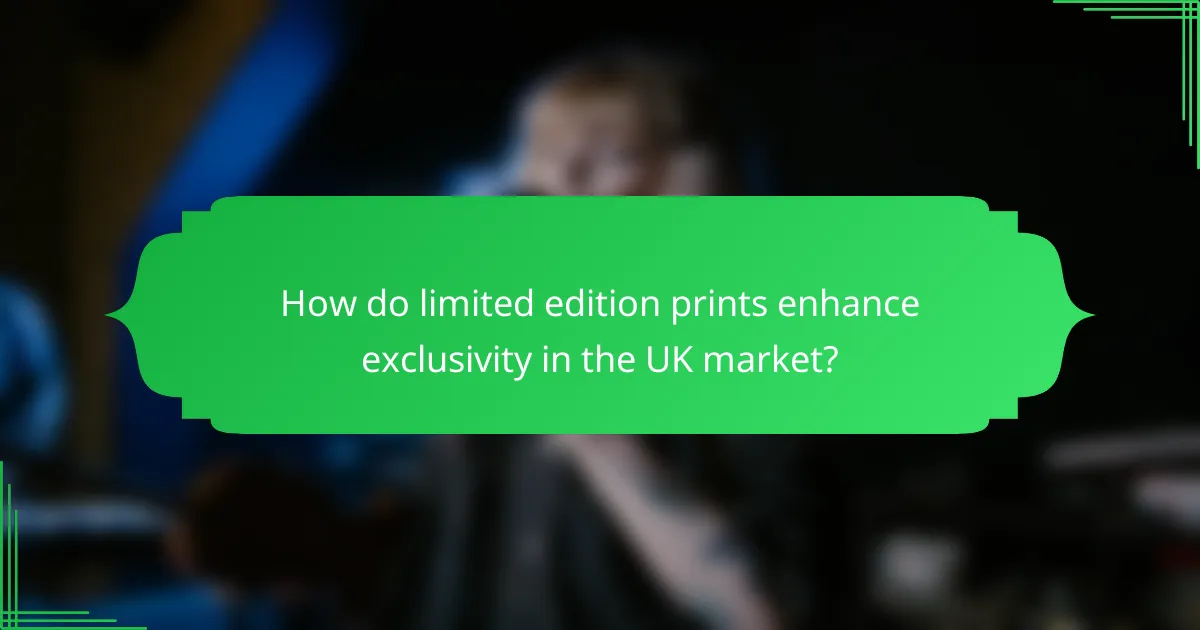
How do limited edition prints enhance exclusivity in the UK market?
Limited edition prints enhance exclusivity in the UK market by creating a sense of scarcity that appeals to collectors and art enthusiasts. This exclusivity not only elevates the perceived value of the prints but also strengthens the reputation of the artists involved.
Scarcity increases perceived value
Scarcity is a key factor in determining the perceived value of limited edition prints. When artworks are available in limited quantities, collectors often view them as more desirable, leading to higher demand and potential resale value. For example, a print limited to 50 copies may command a significantly higher price than an open edition.
In the UK market, this principle is particularly relevant as collectors are willing to pay premium prices for artworks that are hard to come by. The allure of owning something rare can drive prices up, especially in auctions or secondary markets.
Unique artist signatures
Artist signatures on limited edition prints serve as a mark of authenticity and individuality, further enhancing their exclusivity. A signature not only confirms the artist’s involvement but also adds a personal touch that collectors appreciate. This can lead to a stronger connection between the artwork and its owner.
In the UK, prints that feature unique signatures can often fetch higher prices, as collectors seek to own pieces that are directly linked to the artist’s hand. This personal connection can be a significant factor in the resale market, where signed works are often more sought after.
Numbered editions
Numbered editions provide a clear indication of how many prints exist, reinforcing the concept of exclusivity. Each print is typically labeled with its edition number, such as 1/50, which informs collectors of its rarity. This transparency helps buyers understand the value of their investment.
In the UK, the practice of numbering prints is common and can significantly influence resale prices. For instance, lower-numbered prints, like 1/50 or 2/50, may be more desirable than higher numbers, as collectors often prefer earlier editions. This can create a hierarchy of value within the same series of prints.
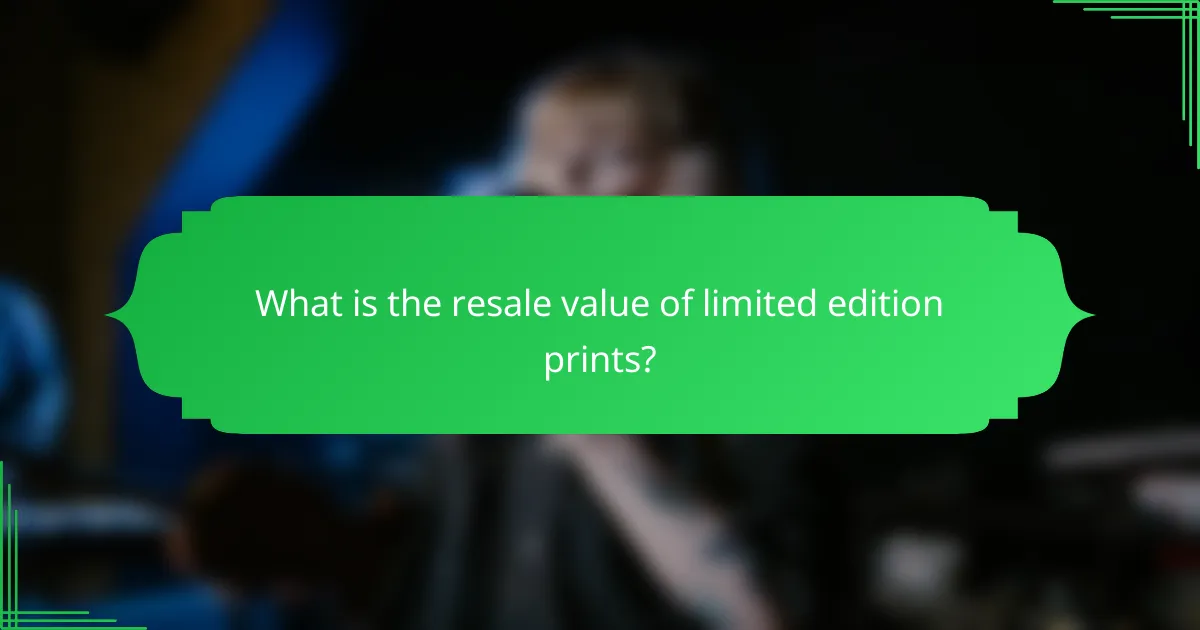
What is the resale value of limited edition prints?
The resale value of limited edition prints can vary significantly based on factors such as market demand, the artist’s reputation, and the print’s condition. Generally, these prints can appreciate in value, especially if they are from well-known artists or have a strong collector following.
Market demand influences prices
Market demand plays a crucial role in determining the resale value of limited edition prints. When a particular artist gains popularity or if a specific style becomes trendy, the prices for their prints can rise sharply. Collectors are often willing to pay a premium for prints that are perceived as exclusive or highly sought after.
For example, prints from contemporary artists who have recently gained recognition at major art fairs may see resale values increase by 20-50% shortly after their initial release. Conversely, if interest wanes, prices may stagnate or even decline.
Historical sales data
Analyzing historical sales data can provide insights into the potential resale value of limited edition prints. Auction results and sales from galleries often indicate how similar works have performed over time. Tracking these trends can help collectors make informed decisions about purchasing prints.
For instance, if a limited edition print consistently sells for higher prices at auction, it may signal a strong investment opportunity. Collectors should look for patterns in sales over several years to gauge stability and growth in value.
Condition and provenance
The condition and provenance of a limited edition print significantly affect its resale value. Prints that are well-preserved, free from damage, and come with a documented history tend to command higher prices. Collectors should ensure that prints are stored and displayed properly to maintain their condition.
Additionally, having a clear provenance, such as previous ownership by a notable collector or exhibition history, can enhance a print’s appeal. Buyers often prefer prints with verifiable backgrounds, as this adds to their authenticity and desirability in the market.
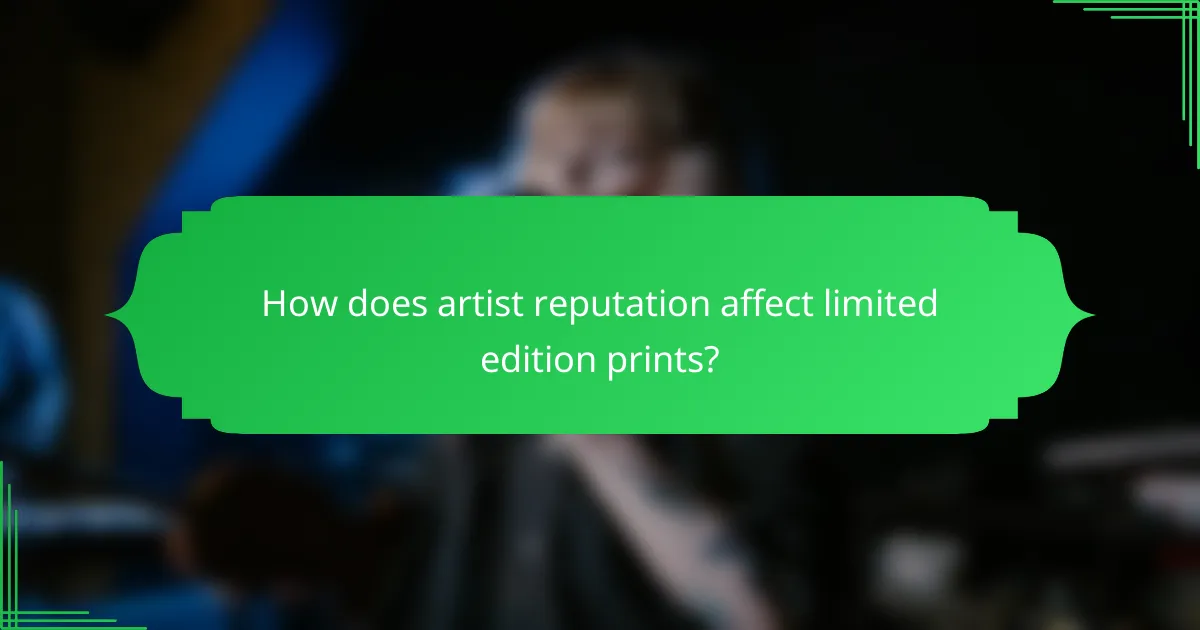
How does artist reputation affect limited edition prints?
Artist reputation significantly influences the value and desirability of limited edition prints. Established artists often see higher demand and prices due to their proven track record, while emerging artists may fluctuate in value based on market trends and public perception.
Established artists command higher prices
Limited edition prints by established artists typically command premium prices, often reaching thousands of dollars. Collectors are willing to invest more in works by artists with a strong history of sales, exhibitions, and critical acclaim. For instance, prints from renowned artists like Banksy or Yayoi Kusama can sell for tens of thousands of dollars, reflecting their established status.
Furthermore, the resale market for prints by well-known artists tends to be robust, with many pieces appreciating in value over time. This creates a cycle where high demand leads to higher prices, further solidifying the artist’s reputation and market position.
Emerging artists and market trends
Emerging artists often face a more volatile market for their limited edition prints. Prices can vary widely based on current trends, media exposure, and the artist’s ability to connect with collectors. While some emerging artists may see rapid increases in value, others may struggle to gain traction.
Collectors interested in prints from emerging artists should consider factors such as the artist’s exhibition history, social media presence, and participation in art fairs. Investing in these prints can be a gamble, but it also offers the potential for significant returns if the artist gains recognition.
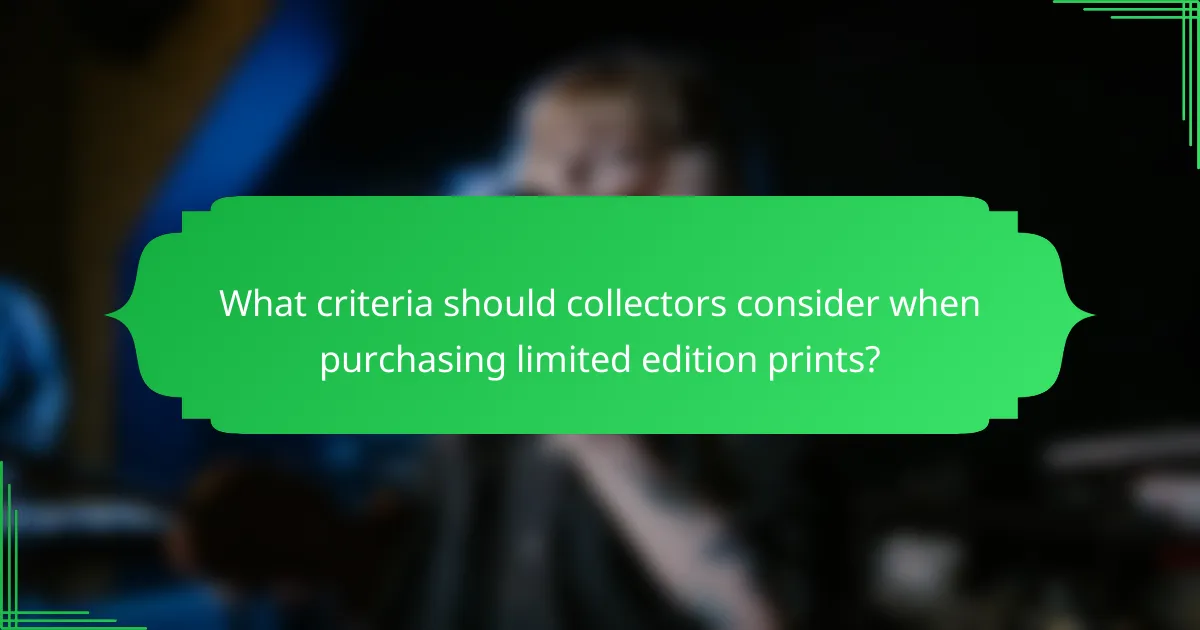
What criteria should collectors consider when purchasing limited edition prints?
Collectors should focus on factors such as edition size, artist reputation, print quality, and materials when purchasing limited edition prints. These elements significantly influence the print’s exclusivity, potential resale value, and overall appeal.
Edition size and artist recognition
The edition size refers to the total number of prints produced, which directly impacts scarcity. Smaller editions, often ranging from a few to a couple hundred, tend to be more desirable and can command higher prices in the resale market.
Artist recognition plays a crucial role in the value of limited edition prints. Established artists with a strong reputation typically see their works appreciate over time, while emerging artists may offer more affordable options but with less predictable resale value.
Print quality and materials
High-quality prints are produced using superior materials and techniques, such as archival inks and acid-free paper, ensuring longevity and visual appeal. Collectors should look for prints that are signed and numbered by the artist, as these factors enhance authenticity and value.
When assessing print quality, consider the printing method used. Techniques like lithography or giclée printing are often preferred for their detail and color accuracy. Investing in prints made with these methods can lead to better long-term satisfaction and potential appreciation in value.
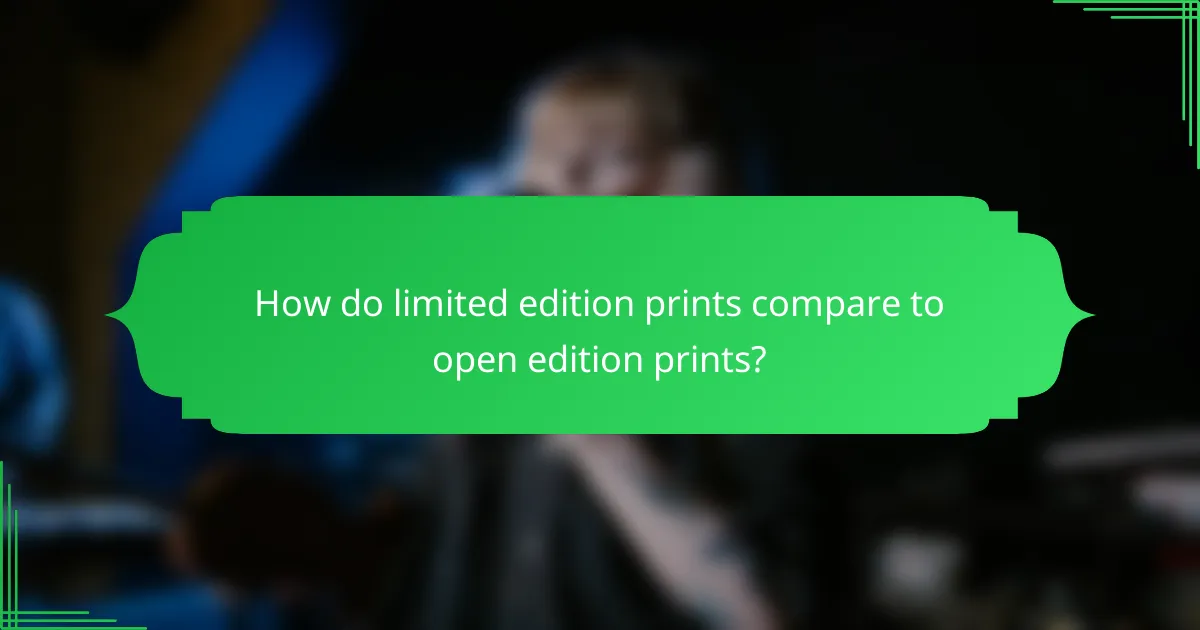
How do limited edition prints compare to open edition prints?
Limited edition prints are produced in a restricted quantity, enhancing their exclusivity and potential resale value compared to open edition prints, which can be reproduced indefinitely. This scarcity often elevates the artist’s reputation and the print’s desirability among collectors.
Value retention over time
Limited edition prints generally retain or even increase their value over time, especially if the artist gains recognition or if the print is well-regarded. In contrast, open edition prints typically depreciate, as their availability is not restricted, making them less appealing to collectors.
For instance, a limited edition print by a well-known artist might appreciate by 20-50% within a few years, while an open edition print may only be worth a fraction of its original price after the same period. Factors influencing value retention include the artist’s career trajectory, market demand, and the print’s condition.
Collectibility factors
Several factors contribute to the collectibility of limited edition prints, including the number of prints produced, the artist’s reputation, and the print’s historical significance. A lower edition number often correlates with higher demand, making these prints more sought after.
Additionally, provenance plays a crucial role; prints with a well-documented history or those that have been featured in prestigious exhibitions tend to attract collectors. When considering a purchase, verify the edition number and seek prints that come with certificates of authenticity to ensure their value and legitimacy.
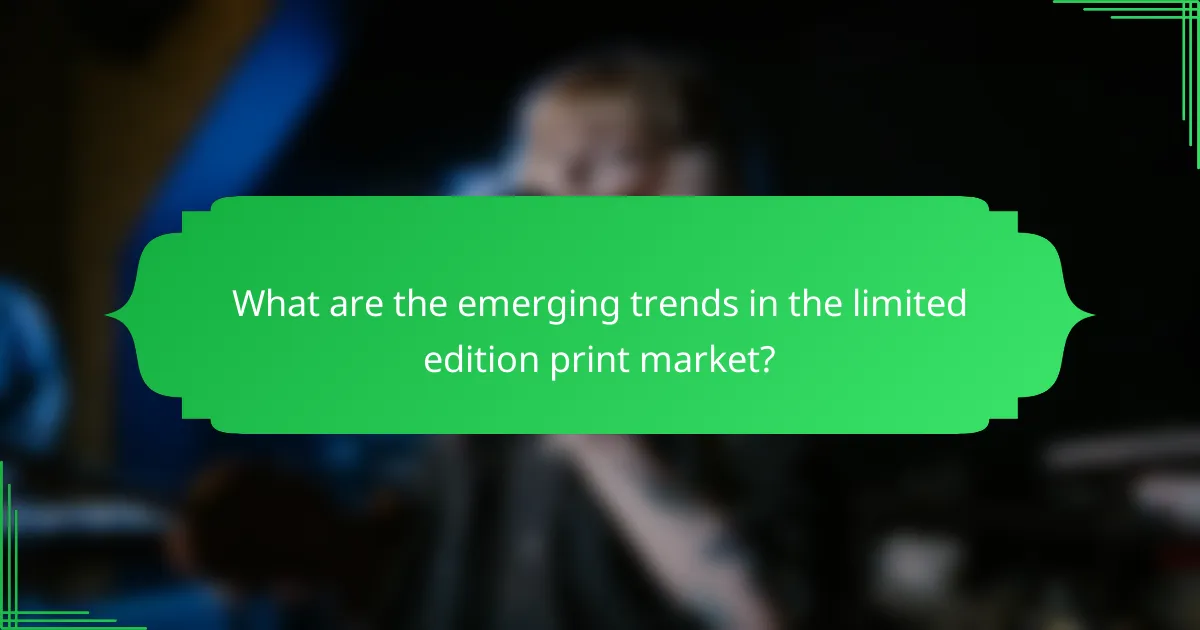
What are the emerging trends in the limited edition print market?
The limited edition print market is evolving with notable trends that enhance exclusivity and potential resale value. Key developments include the rise of digital art and NFTs, as well as collaborations between artists and brands, which are reshaping how collectors perceive and invest in these artworks.
Digital art and NFTs
Digital art and non-fungible tokens (NFTs) have transformed the limited edition print landscape by offering unique ownership rights and provenance tracking. Artists can create limited runs of digital prints, each linked to a specific NFT, ensuring authenticity and scarcity.
This trend allows collectors to invest in digital works that can appreciate over time, similar to traditional prints. However, potential buyers should be cautious of market volatility and ensure they understand the technology behind NFTs before making purchases.
Collaborations with brands
Collaborations between artists and brands are becoming increasingly popular in the limited edition print market. These partnerships often result in exclusive releases that attract both art enthusiasts and brand loyalists, enhancing the perceived value of the prints.
When considering such collaborations, collectors should evaluate the reputation of both the artist and the brand involved. Limited editions created through these partnerships can command higher resale prices, especially if they tap into current trends or cultural moments.
